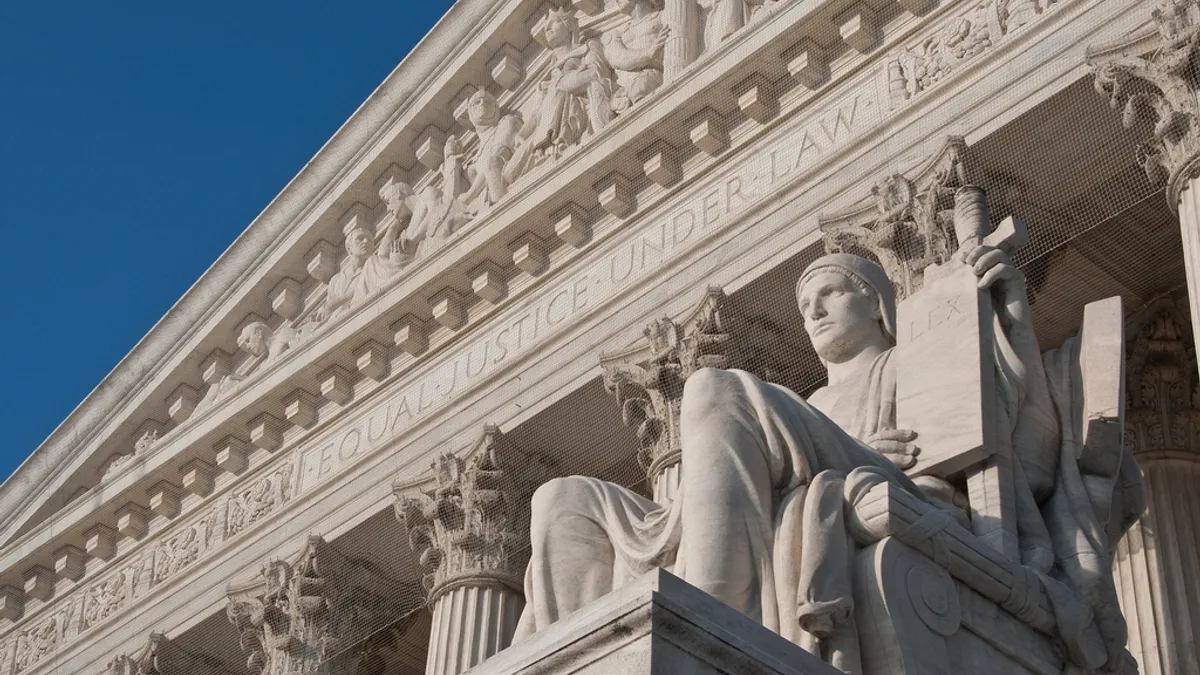Dive Brief:
- The U.S. Supreme Court on Monday released a ruling to reject the EPA's Mercury and Air Toxics Standards (MATS), a regulatory package aimed at reducing the emission of mercury and other harmful pollutants from power plants, especially those that burn coal.
- The court ruled in a 5-4 decision that the EPA interpreted the Clean Air Act improperly in crafting the regulation because it did not consider the costs of emissions reductions. The decision overturns an April 2014 ruling from the D.C. Circuit Court, which found the EPA acted within its legal mandate. The Supreme Court remanded the regulation to the D.C. Circuit, which must now decide how to proceed with the EPA.
- The ruling, however, is expected to have a relatively modest impact on the generation mix of the nation's utilities. As multiple outlets have noted, power companies have already largely complied with the EPA's regulations, retiring thousands of megawatts of coal power plants this year alone.
Dive Insight:
The Supreme Court has handed a significant symbolic defeat to President Obama's environmental legacy, striking down the Environmental Protection Agency's Mercury and Air Toxics Standards (MATS). The regulatatory package was finalized in 2012 and aimed to reduce the amount of mercury and other toxic pollutants emitted by U.S. power plants.
Michigan led a coalition of states and industry groups in arguing that the EPA did not properly consider the costs of compliance for the MATS regulations when crafting the rules. The Clean Air Act, a 1970 law on which MATS is based, requires the agency to issue regulations that it deems "appropriate and necessary," but offers little guidance as to what that means. Industry groups have argued since the rule was proposed that it would be the costliest regulatory package ever, and could even result in rolling blackouts.
The Court on Monday sided with the states and industry groups, ruling that EPA must consider compliance costs as a part of its mandate to issue "appropriate and necessary" regulations. Justice Antonin Scalia, a reliable conservative on the bench wrote the majority opinion in the case, Michigan vs. EPA.
"EPA must consider cost—including cost of compliance—before deciding whether regulation is appropriate and necessary. It will be up to the Agency to decide (as always, within the limits of reasonable interpretation) how to account for cost," Scalia wrote.
The decision overturns an April 2014 ruling from the D.C. Circuit Court, the top appeals court in the country, that found the EPA acted within its legal mandate in issuing the rules. The High Court remanded the decision to the D.C. Circuit, which must now decide whether it will tell the EPA to reconsider the rule or start from scratch.
The decision could have long-term impacts for the way the EPA makes regulations. In ruling that the EPA must consider compliance costs when making new rules, it could change the way EPA interacts with energy stakeholders and state lawmakers in ways that remain to be seen.
The impact of the ruling on the nation's power supply is expected to be somewhat muted, however. Because the MATS regulation had a compliance deadline of April 16, 2015, power companies have already largely chosen to retire or retrofit coal plants that would be impacted by the rule, despite the uncertainty that surrounded its legality. Multiple utilities told Bloomberg BNA in April that the MATS ruling would not affect their already-scheduled plant closures. AEP, Duke, FirstEnergy and other major coal utilities have already retired thousands of gigawatts of coal generation this year.
Many power companies, however, were able to win extensions to the MATS deadline for plants deemed critical to electric reliability, mostly to finish installing mercury controls. As SNL reports, some 200 power plants, comprising 20% of U.S. generating capacity, were given another year to meet MATS deadlines, and units with more than 26 GW of capacity are undergoing installation of pollution scrubbers and are expected to come online by 2019. The fate of those plants, and their emission reduction technologies, now depends on how the D.C. Circuit and EPA plan on reworking the rule.














